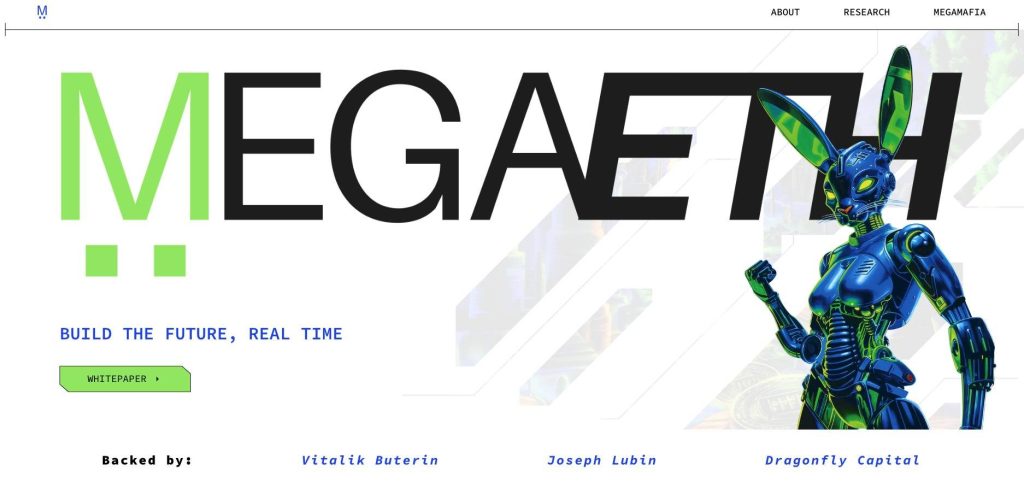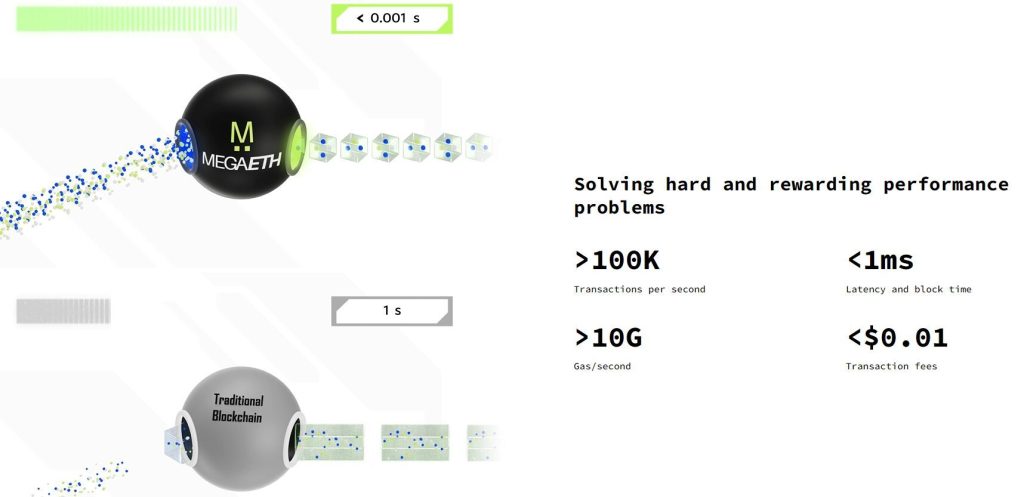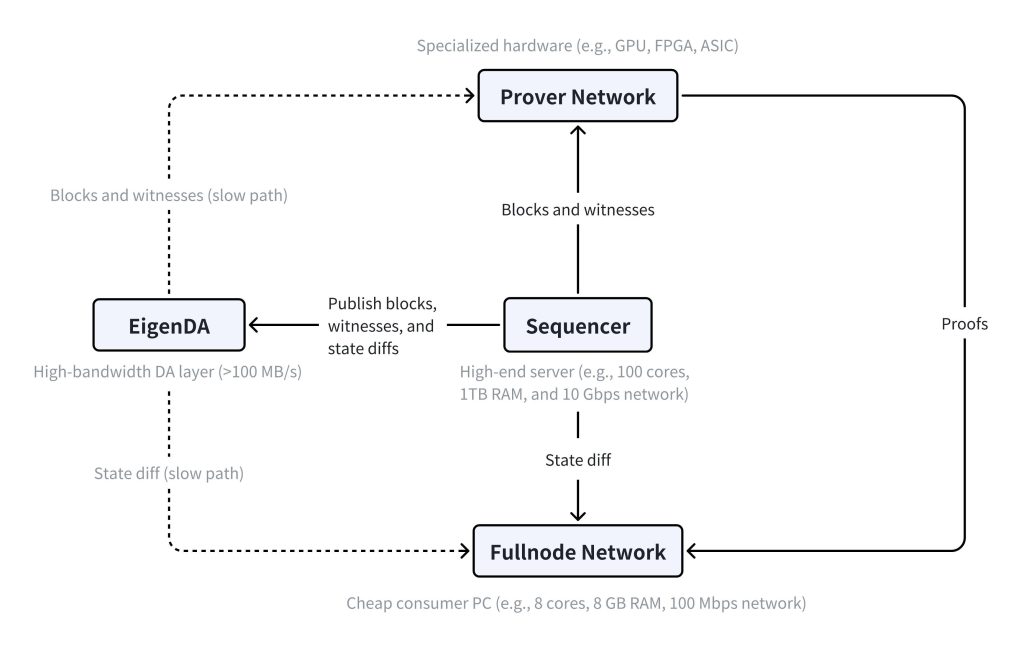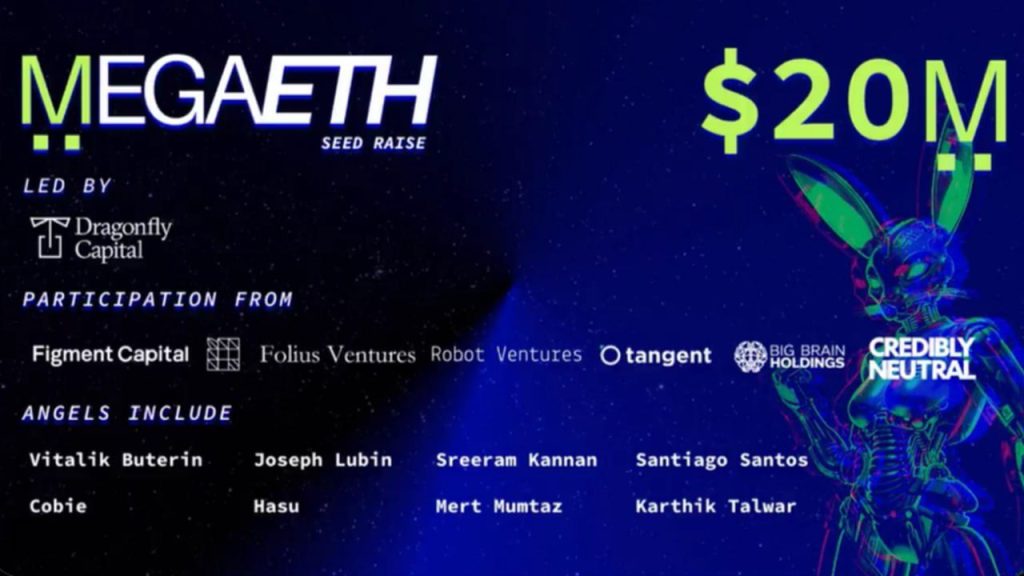MegaETH is a Layer 2 solution that processes over 100,000 transactions per second, a feat no other project has achieved. Recently, it closed $20 million in a seed round that welcomed some famous faces in the crypto sphere, including Vitalik Buterin.

What is MegaETH?

MegaETH is a Layer 2 solution built on the Ethereum network with full EVM compatibility. Its main claim to fame lies in the investment by Ethereum founders Vitalik Buterin and Joseph Lubin. According to its ambition, it will be the world’s fastest blockchain, processing over 100,000 TPS, which is way higher than Solana’s 2,000-4,000 TPS.
MegaETH was designed to allow Ethereum to expand infinitely while ensuring super-fast speed and extremely low gas fees. If it can reach 100,000 TPS, then Layer 2 will be many dozen times faster than its peers in the industry, thus serving all of the users’ demands and facilitating massive adoption of a wide array of complex Dapps like games, AI, and DeFi protocols at large scales.
Read More: TON Blockchain Layer 2 Coming Soon With the Support of Polygon’s Technology
MegaETH Product

MegaETH is a layer-2 platform on Ethereum that enables the building of dApps using the Solidity programming language. It is highly compatible with the Ethereum Virtual Machine, so DApps from the EVM chains can be easily migrated to run on Layer 2.
Additional opportunities to earn through this layer come from becoming a Sequencer, Prover or Full node operator to Layer 2 to receive transaction fees and revenues from MEV on the platform.
Read More: Initia Review: Blockchain combines Layer 1 and Layer 2
Main Components of MegaETH
Traditional blockchain scalability research has come at the expense of performance. MegaETH evades this by using Ethereum for security and EigenDA for censorship resistance. The two major components of MegaETH’s solution are consensus and execution. The former orders the transactions, while the latter processes them to update the state of the blockchain.
At Layer 1, every node is equal, running a consensus protocol and executing every transaction locally, thus balancing performance and decentralization. Because the requirements are different from project to project, each Layer 1 has to specify minimum hardware requirements for the nodes in a manner that ensures security and censorship resistance at the nodes.

The architecture of MegaETH will rely on three major components: the sequencer, the prover, and full nodes. The sequencer is responsible for ordering user-submitted transactions. The real meaning in the common case is that MegaETH has a single sequencer to get rid of consensus overhead. Most of the full nodes receive state diffs via the P2P Network, and apply to update their local state directly.
Full nodes wouldn’t need to re-execute transactions; rather, it would indirectly validate blocks based on the proofs presented by the Prover. Since it has a lower rank in the hierarchy, the Stateless validation scheme shall be used by the Prover for the validation of blocks asynchronously and in random order. Lastly, EigenDA shall publish blocks.
Tokenomics
The project plans to launch its native token for network governance but has not set a specific launch date.
Team, Investors and Partner
Team
Yilong Li, Co-Founder & CEO
- Education: Ph.D. Computer Science from Stanford University.
- Experience: He was previously employed with Runtime Verification as a Senior Software Engineer working on aerospace, automotive, and blockchain computer system security.
Shuyao (Rachel) Kong, Co-Founder & CBO
- Education: MBA Harvard Business School.
- Experience: 7 years as Head of Global Business Development at Consensys. Presently, Advisor at Consensys is constructing MegaETH and humanID, a user identity authentication solution.
Namik Muduroglu | Head of Growth
- Experience: Closing on a year as a Business Strategy Developer at Consensys. Outside of MegaETH, he is building humanID as a founder and board member.
- Education: NYU Stern School of Business Class of 2014, B.A., Economics.
MegaETH was founded in early 2023 and is backed by a well-experienced team in the blockchain space. Close interaction has been maintained with Consensys Company since two of its core team members previously worked there: Shuyao Kong and Namik Muduroglu.
Investors

On June 27, 2024, MegaETH successfully closed its seed round with $20 million, led by DragonFly Capital. Other participating funds included Figment Capital, Robot Ventures, and Big Brain Holdings. Notably, angel investors such as Vitalik Buterin, Co-Founder of Ethereum; Joseph Lubin, Co-Founder of Ethereum & Consensys; Sreeram Kannan, Co-Founder of EigenLayer; and Kartik Talwar, Co-Founder of ETHGlobal, also contributed.
Roadmap
It will launch its public testnet in early Q3 2024, with its mainnet expected towards the end of the year.
Conclusion
MegaETH aims to be the first blockchain to achieve 100,000 TPS, and it has the backing of Ethereum founders Vitalik Buterin, Joseph Lubin, and the Consensys team.
CoinCu sees this project as a prime opportunity for airdrops and investment. Its faster, cheaper, and more efficient Blockchain is pivotal for driving mass crypto adoption and building dApps.
FAQs
1. What are some of the key features of MegaETH?
These include, among others, high transaction throughput, low latency, full EVM compatibility, and very minimal transaction costs.
2. How does MegaETH ensure high transaction speed?
MegaETH deploys cutting-edge blockchain technology to propel more than 100,000 transactions per second.
3. How much is the latency for transactions on MegaETH?
Less than 1 ms, thereby making the transactions almost instant.
| DISCLAIMER: The information on this website is provided as general market commentary and does not constitute investment advice. We encourage you to do your own research before investing. |
















